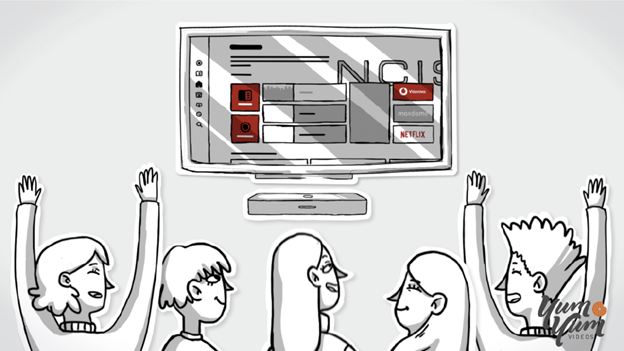A huge reason behind video marketing's popularity rests in the mediums' effectiveness at achieving a relatively specific marketing goal—depending on the style, format, and type of video you go with.
You have a lot of room with the medium to craft something specifically tailored to what you need.
The Whiteboard animation style, for example, primarily excels at condensing information and communicating data in ways most viewers would find engaging and easy to follow. It's what the style is meant to do.
But beyond that core design purpose, whiteboard animation pieces lend themselves to some uniquely powerful branding techniques, too.
Using visual and design elements that help your content feel unmistakably yours, they can make viewers far more likely to think about and remember your brand.
So, to make the most out of your whiteboard videos, you should be taking advantage of those design opportunities. That's exactly what this article discusses.

What Makes a Marketing Video Memorable?
The more memorable you can make a piece of marketing material, the better the chances that your business will achieve the results you want. It's an essential marketing principle that's particularly important for video content, which tends to require significant amounts of time and resources to produce and get right.
But what makes a marketing video memorable?
- Content would usually jump at the top of the list. Whatever information you are sharing, you need to do so in a clear and compelling way.
- Relatability comes at a close second. The more personal and relatable your video, the better its chances of resonating and sticking with your viewers.
- Then, you have things like making your video distinctive enough to stand out and giving it some visual cues that give them that little extra branding push!
What Are Whiteboard Videos, and How Do They Work?
Whiteboard videos are a type of explainer that uses particular aesthetic cues to get the job done.
In a nutshell, the style features a white background that emulates the titular "white board"; in the foreground, lines are constantly being drawn into shapes that animate and transition into the next drawing, helping you convey a narrative or message.
It's a purposely minimalistic style meant to limit distractions while using visual communication elements that help you get a complex message across in a very easy-to-follow way.
It has grown fairly popular over the years because it provides a reliable way to deliver a lot of data to the viewers in ways they'll remember.
The challenge, however, is that the streamlined nature of whiteboard videos might come across as "simplistic" to the untrained eye. Which can lead to uninspired pieces that fail to capture your audience's attention or portray your brand and message as well as they could.
Yes, at its core, the whiteboard video formula is pretty straightforward: Simulate line illustrations being drawn on a solid white background, which then animate and transition to help convey your narrator's message.
But how do those general principles for memorable branded videos we talked about translate into practical design elements that elevate your whiteboard videos' brand permanence?
Well, you embody them in your script, characters, colors, and iconic elements...
A Memorable Whiteboard Video Script Is the Foundation
Think of your whiteboard video script as the structure upon which you build everything else. As such, the script is the first major element you'll be able to customize to start polishing your video's branding capabilities.
The good news is that, because it's for a type of explainer video, the path has already been laid for you to follow!
The popular three-act structure that most explainer videos use—opening by showcasing your audience's pain point, introducing and explaining your solution in detail, and highlighting the potential benefits and a call to action—already gives you a tried-and-true template to follow.
However, as you work on adapting that structure to your needs, you'll want to adhere to a few vital tips to improve your video's recallability:
- Keep your language and definitions as simple as possible. Jargon is OK only if you think the overwhelming majority of your viewers already use it regularly.
- Talk directly to viewers, framing your script from a second-person perspective ("Remember when you...?"; "On your profile page...")
- Frame everything within a narrative or story that mirrors the core experience of most of your viewers.
Fleshing Out Characters That Represent Your Audience
Since most marketing-oriented whiteboard videos rely on a core narrative to carry your message to viewers, most of them also use characters to bring that narrative to life.
Those characters, more than most other visual elements in play, give you a huge opportunity to craft something that resonates with your viewers on a personal level.
Yes, those cartoon characters are only abstract representations of generalities, but if you are making content to appeal to a certain audience, that group likely shares any number of commonalities and characteristics—which should inform how the characters in your video look and behave.
That's precisely why experienced video production studios tend to do a lot of audience research before developing the assets for an animated video. The goal is to truly understand those for whom the video is intended and to model its elements in ways that audience finds compelling and representative.
The better you are at crafting visually interesting characters that your viewers can see themselves in, the more compelling and memorable those characters and their message will be to your audience.

A Black & White Canvas to Help Color Make a Lasting Impression
Having animated black-lined illustrations on a white background is the staple recipe of the whiteboard video style. And there are good reasons for it!
Meant to emulate a similar vibe to the typical "classroom explanation," this signature minimalistic approach is meant to minimize distractions and focus the viewers' attention on what's being explained. That way, you create a piece that makes it far easier to condense and communicate a lot of data in a short amount of time.
But, even though this particular style hinges primarily on this B&W setup, color still plays a vital role.
You can, and should, choose from your brand's color palette, particularly the main color that represents your company across most of your marketing content. Then, use it as an accent or highlight for important on-screen elements that are intricately tied to your company, solution, or message.
That simple technique lets you start building a visual narrative that subtly injects your brand into your video's story and establishes an implied connection in your viewer's mind between your content and your company.

Introducing Your Logo in a Meaningful Way
Just as you want your primary branding color to be displayed in meaningful ways, introducing your logo at the right time and in the right way can do a fantastic job of tying your whiteboard video to your brand.
Going back to the three-act structure that most whiteboard videos follow: it has become a common and useful practice to use your logo as part of the illustrations that represent your product or solution when transitioning to the second act of your piece.
By doing so, you are placing your brand front and center without making it forced or tacky. What's more important, by tying your company's logo to the video's narrative in this way, you get to form a connection between the two in your viewer's mind—making recall of you product and brand as a unit more likely long after viewing.
The Gist of Whiteboard Videos for Branding
Every type of marketing video has unique attributes that make it better at some particular tasks than others.
Whiteboard videos are primarily a medium that excels at engaging and conveying lots of information to your viewers in a short amount of time.
But with the right visual and production elements to brand your piece the right way, you can also make whiteboard videos carry your company's banner and ensure that viewers will keep you in their thoughts long after watching.
More Resources on Whiteboard Videos for Marketing
Five Steps to Making an Excellent Explainer Video (Article 3 of 3)
10 Things You Can Do With an Explainer Video (And Why You Should Do Them) [Infographic]




